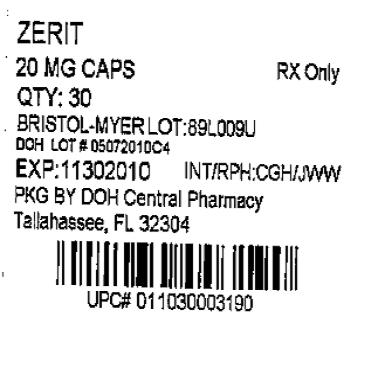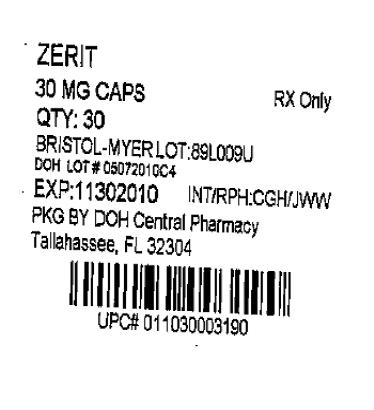Zerit | Stavudine Capsule, Gelatin Coated while Breastfeeding

What is Zerit | Stavudine Capsule, Gelatin Coated used for?
What are the risk associated with Zerit | Stavudine Capsule, Gelatin Coated usage while breastfeeding? What precautions shall I take while using it in breastfeeding?
Nursing Mothers The Centers for Disease Control and Prevention recommend that HIV-infected mothers not breast-feed their infants to avoid risking postnatal transmission of HIV. Studies in lactating rats demonstrated that stavudine is excreted in milk. Although it is not known whether stavudine is excreted in human milk, there exists the potential for adverse effects from stavudine in nursing infants. Because of both the potential for HIV transmission and the potential for serious adverse reactions in nursing infants, mothers should be instructed not to breast-feed if they are receiving ZERIT.
Zerit | Stavudine Capsule, Gelatin Coated Breastfeeding Analsys
Stavudine while Breastfeeding
CAS Number: 3056-17-5
In the United States and other developed countries, HIV-infected mothers should generally not breastfeed their infants. Published experience with stavudine during breastfeeding is limited. In countries in which no acceptable, feasible, sustainable and safe replacement feeding is available, World Health Organization guidelines recommend that all women with an HIV infection who are pregnant or breastfeeding should be maintained on antiretroviral therapy for at least the duration of risk for mother-to-child transmission. Mothers should exclusively breastfeed their infants for the first 6 months of life; breastfeeding with complementary feeding should continue through at least 12 months of life up to 24 months of life.[1] The first choice regimen for nursing mothers is tenofovir, efavirenz and either lamivudine or emtricitabine. If these drugs are unavailable, alternative regimens include: 1) zidovudine, lamivudine and efavirenz; 2) zidovudine, lamivudine and nevirapine; or 3) tenofovir, nevirapine and either lamivudine or emtricitabine. Exclusively breastfed infants should also receive 6 weeks of prophylaxis with nevirapine. Stavudine should not be used in first-line regimens because of its metabolic toxicities.[2][3]

I already used Zerit | Stavudine Capsule, Gelatin Coated and meanwhile I breastfed my baby should I be concerned?
We are not completely sure about safety of Zerit | Stavudine Capsule, Gelatin Coated in breastfeeding. We would suggest you to contact your doctor or health care provider and explain your situation with Zerit | Stavudine Capsule, Gelatin Coated. If you observe anything abnormal with your baby please call 911 or contact emergency services in your area.
My health care provider has asked me to use Zerit | Stavudine Capsule, Gelatin Coated, what to do?
If your doctor considers Zerit | Stavudine Capsule, Gelatin Coated safe enough to prescribe for you that means its benefits outweigh its known risks.
If I am using Zerit | Stavudine Capsule, Gelatin Coated, will my baby need extra monitoring?
Not Sure, Please check with your doctor or lactation consultant.
Who can I talk to if I have questions about usage of Zerit | Stavudine Capsule, Gelatin Coated in breastfeeding?
US
National Womens Health and Breastfeeding Helpline: 800-994-9662 (TDD 888-220-5446) 9 a.m. and 6 p.m. ET, Monday through Friday
UK
National Breastfeeding Helpline: 0300-100-0212 9.30am to 9.30pm, daily
Association of Breastfeeding Mothers: 0300-330-5453
La Leche League: 0345-120-2918
The Breastfeeding Network supporter line in Bengali and Sylheti: 0300-456-2421
National Childbirth Trust (NCT): 0300-330-0700
Australia
National Breastfeeding Helpline: 1800-686-268 24 hours a day, 7 days a week
Canada
Telehealth Ontario for breastfeeding: 1-866-797-0000 24 hours a day, 7 days a week
